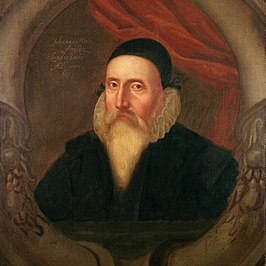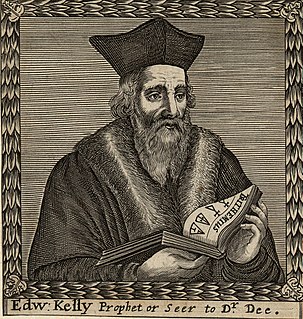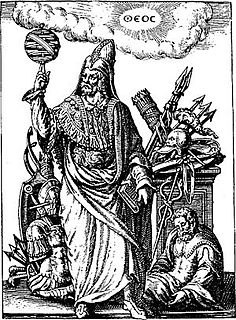| Look up Enochian in Wiktionary, the free dictionary. |
Enochian is an occult or angelic language recorded in the private journals of Dr. John Dee and his seer Edward Kelley in the late 16th century.

Enochian is an occult or angelic language recorded in the private journals of John Dee and his colleague Edward Kelley in late 16th-century England. Kelley was a spirit medium who worked with Dee in his magical investigations. The men claimed that the language was revealed to them by the Enochian angels. The language is integral to the practice of Enochian magic. The syntax and grammar of the Enochian language are highly similar to the English language.

John Dee was an English/Welsh mathematician, astronomer, astrologer, occult philosopher, and advisor to Queen Elizabeth I. He devoted much of his life to the study of alchemy, divination, and Hermetic philosophy. He was also an advocate of England's imperial expansion into a "British Empire", a term he is generally credited with coining.

Sir Edward Kelley or Kelly, also known as Edward Talbot (; 1 August 1555 – 1597/8, was an English Renaissance occultist and self-declared spirit medium. He is best known for working with John Dee in his magical investigations. Besides the professed ability to summon spirits or angels in a "shew-stone" or mirror, which John Dee so valued, Kelley also claimed to possess the secret of transmuting base metals into gold, the goal of alchemy, as well as the supposed Philosopher's Stone itself.
Enochian may also refer to:
- Enochian chess, a four-player chess variant
- Enochian magic, a system of ceremonial magic based on the writings of John Dee and Edward Kelley
- Enochian Theory, a British rock band
Enochian chess is a four-player chess variant, similar to Chaturanga, associated with the Hermetic Order of the Golden Dawn. The name comes from the Enochian system of magic of Dr. John Dee, which was later adapted by Victorian members of the Golden Dawn into "a complete system of training and initiation."

Enochian magic is a system of ceremonial magic based on the evocation and commanding of various spirits. It is based on the 16th-century writings of John Dee and Edward Kelley, who claimed that their information, including the revealed Enochian language, was delivered to them directly by various angels. Dee's journals contained the Enochian script, and the tables of correspondences that accompany it. Dee and Kelley believed their visions gave them access to secrets contained within the Book of Enoch.
Enochian Theory is a rock/metal/progressive rock band, formed in 2004 in Portsmouth, Hampshire, United Kingdom. The original lineup of the band consisted of drummer Sam Street, bass guitarist Shaun Rayment, guitarist Scott Ware, and singer/guitarist/keyboard player Ben Harris Hayes.




